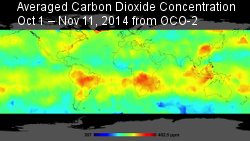Tropospheric Composition

Our group uses measurements, assimilation and modeling to study the composition of the Earth’s troposphere. Our research focuses on developing methods for remote sensing of atmospheric composition and on Earth system modeling to better understand carbon, water and nitrogen cycles and the emissions and transport of tropospheric ozone and ozone precursors. A key feature of our approach is the use of observations of multiple trace gases and other physical quantities in order to provide a comprehensive understanding of the Earth system.
Key science questions our group is focused to addressing include:
- To what extent are anthropogenic emissions and natural processes driving changes in tropospheric composition?
- How do processes such as land-surface exchange, photochemistry, and atmospheric dynamics (including convection and stratosphere-troposphere exchange) control atmospheric concentrations of tropospheric ozone and its precursors as well as carbon dioxide and methane?
- How do changes in tropospheric composition impact the Earth system, including perturbations to the carbon, water and nitrogen cycles?
- What role does tropospheric composition play in short- and long-lived climate forcing, and how does climate influence tropospheric composition?
Tropospheric Composition: Missions and Projects
- CARVE - Carbon in Arctic Reservoirs Vulnerability Experiment
- MLS - Microwave Limb Sounder
- OCO-2 - Orbiting Carbon Observatory-2
- TES - Tropospheric Emission Spectrometer
Our group uses satellite, airborne and ground-based measurements in conjunction with advanced remote sensing techniques and Earth system models in order to address the above science questions. We develop new remote sensing products from existing missions, capitalizing on available information from multiple instruments and spectral regions. We utilize coincident observations of multiple trace gases and physical quantities such as solar-induced fluorescence in model assimilation, analyses, and evaluation in order to guide representation of emissions, chemistry and transport, including convection. We use these observations and model studies to contribute to international assessments of tropospheric composition and climate and to guide the development of future observing systems.